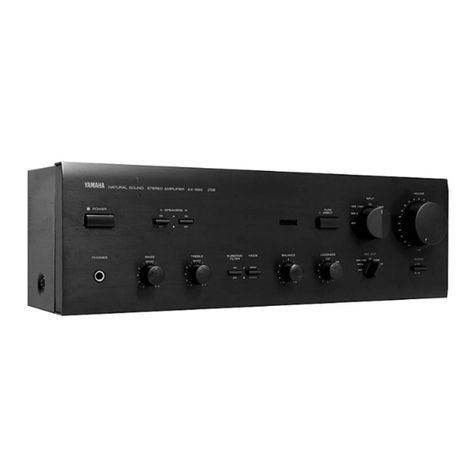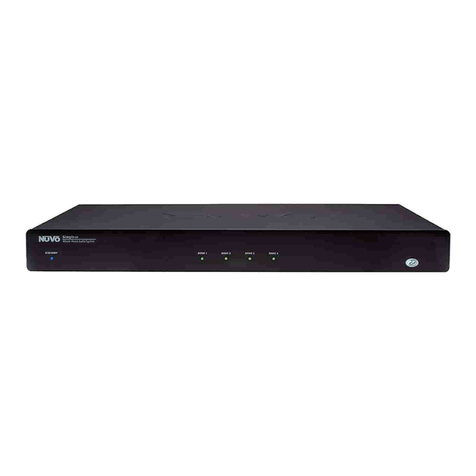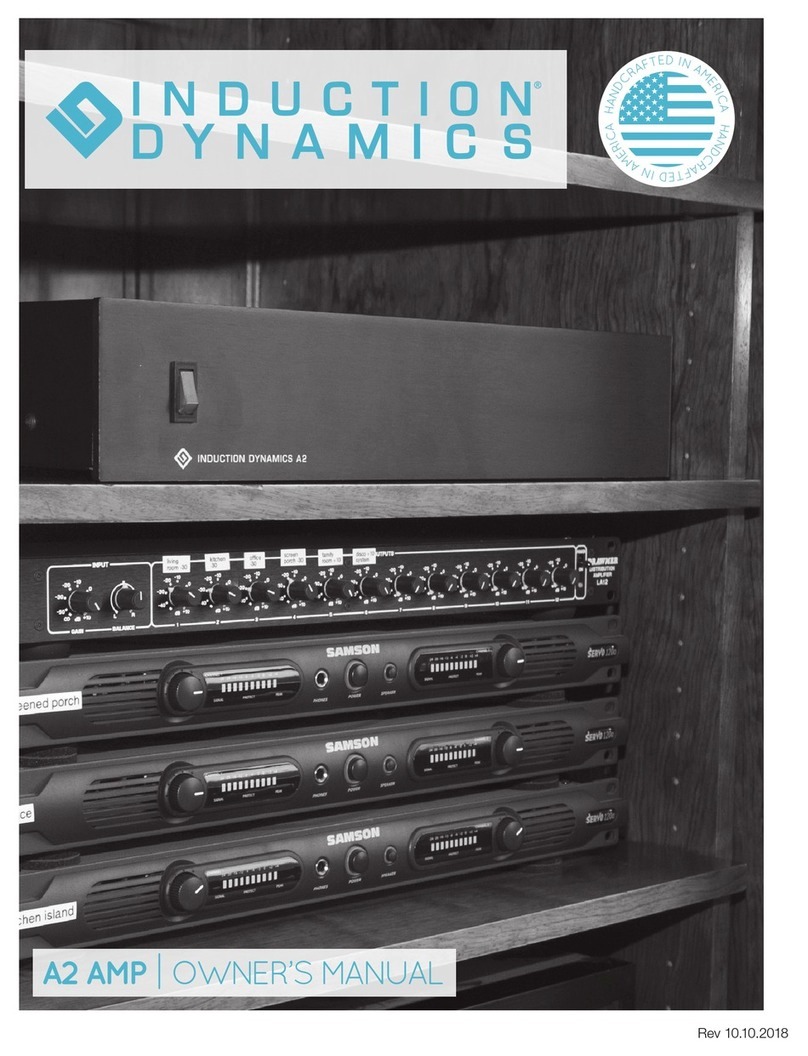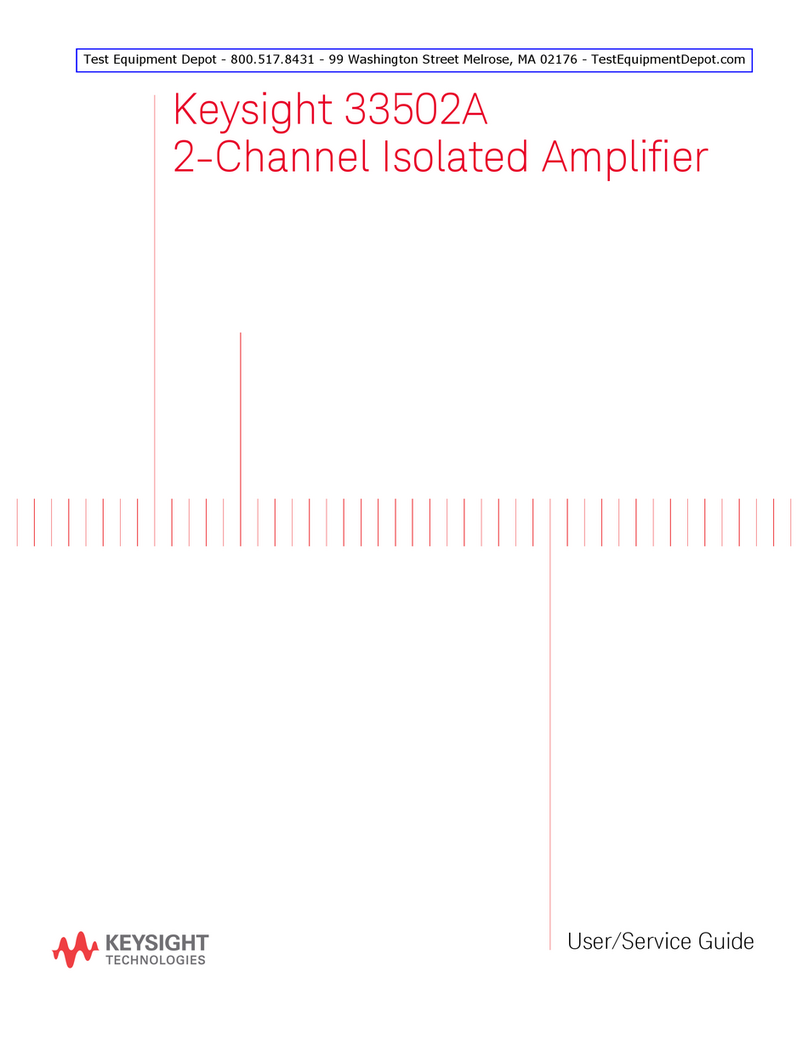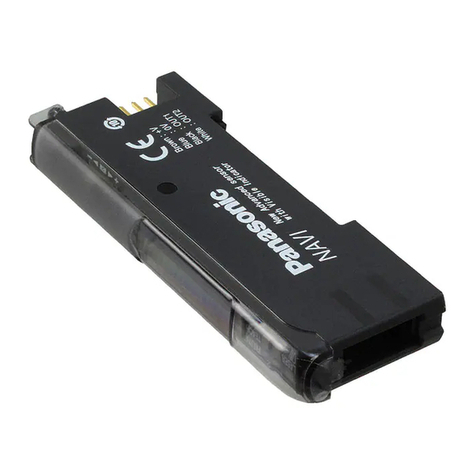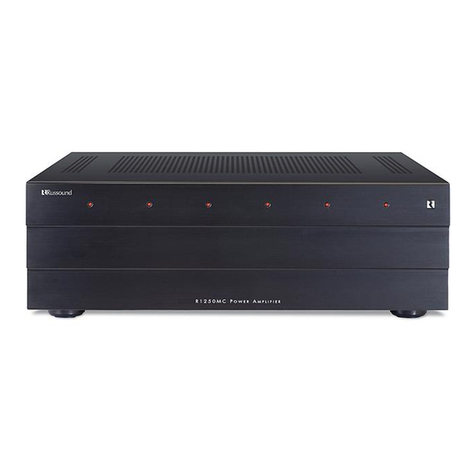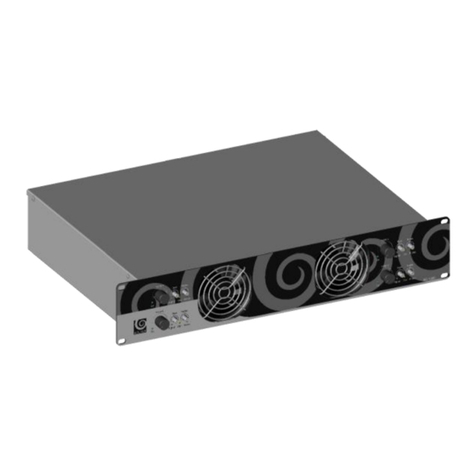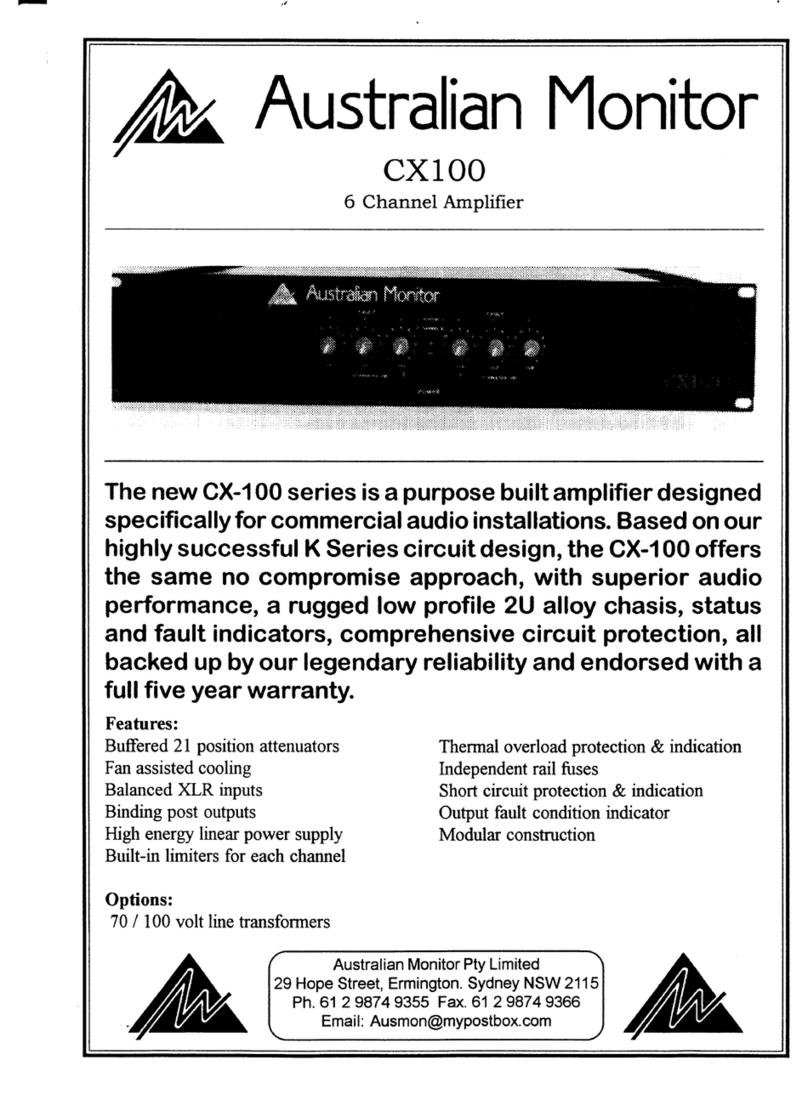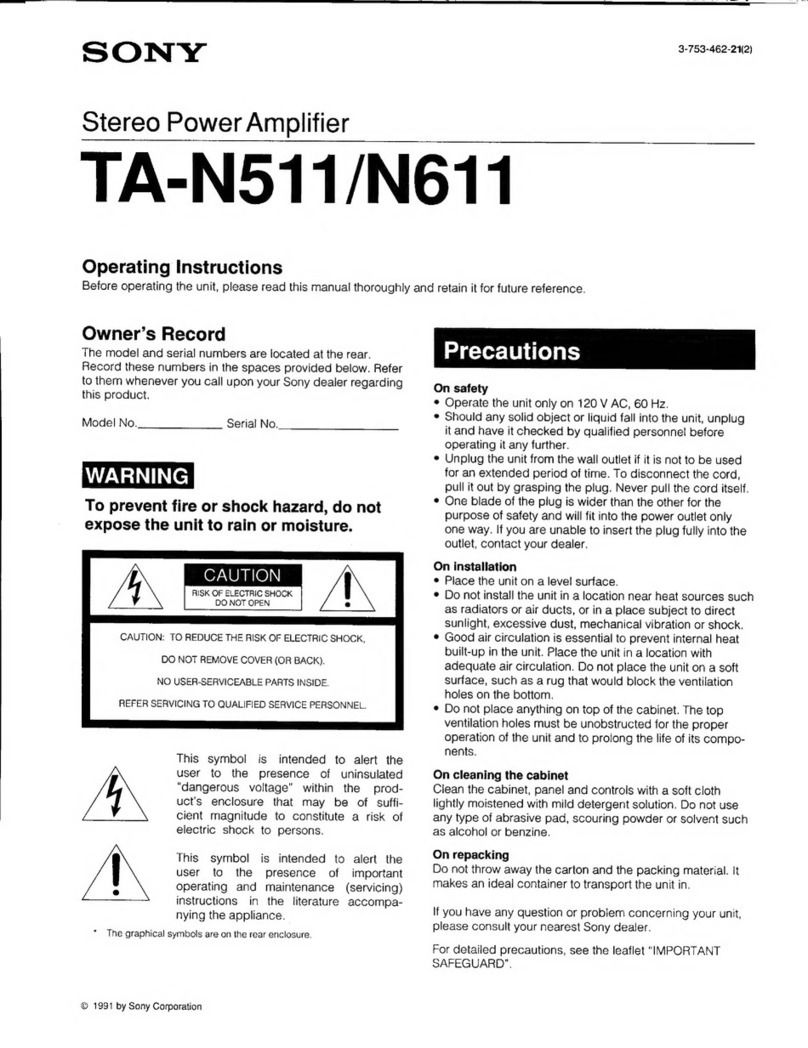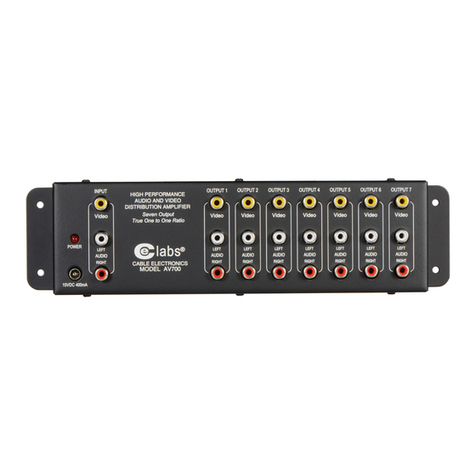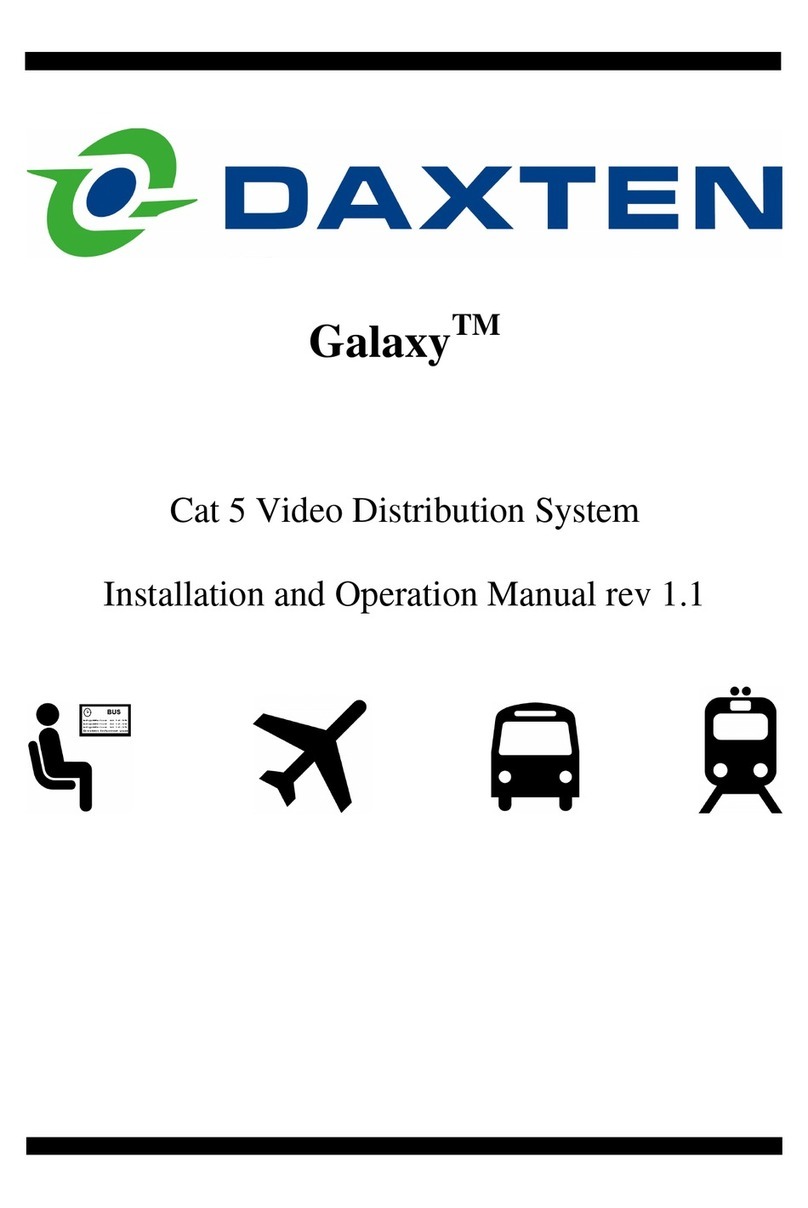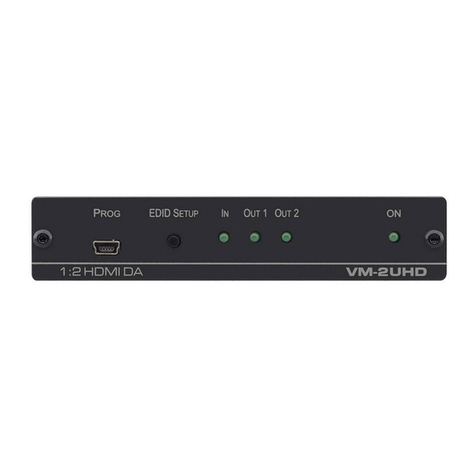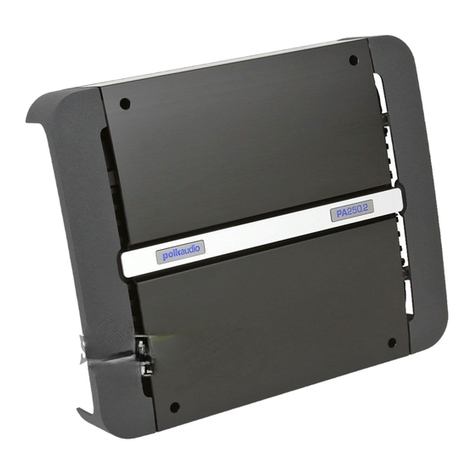TmaiN JOY User manual

JOY
User Manual

JOY
Page 2
WARNING!!!
READ INSTRUCTIONS BEFORE USE OF THE AMPLIFIER
CONTENIDO
SPECIFICATIONS.....................................................................................3
DIMENSIONS............................................................................................3
BEFORE STARTING.................................................................................4
CONTROLS...............................................................................................5
FRONT PANEL ......................................................................................5
USE RECOMMENDATIONS.....................................................................8
OUR COMPROMISE WITH ERGONOMICS.........................................8
PLAYING AT LOW VOLUME.................................................................8
PLAYING AT HIGH VOLUME................................................................9
MIDS CONTROL AND EQUALIZER....................................................10
SPEAKERS CONECTION.......................................................................13
TUBES SELECTION ...............................................................................14
BIAS ADJUSTMENT ...............................................................................14
PROBLEMS.............................................................................................15
CONTACT ...............................................................................................16
Version 1.1

JOY
Page 3
SPECIFICATIONS
-Full-tube single channel amplifier in combo format 110.
-Two 12AX7 tubes in preamp.
JOY12
-Two 6V6 tubes in power stage. Push/Pull A/B cathode bias 12W.
-WGS Veteran 10 speaker, 20W y 8ohm.
JOY22
- Two 6V6 tubes in power stage. Push/Pull A/B fixed bias 20W.
-Celestion G10 Vintage speaker, 60W y 8ohm.
JOY18
-Two EL84 tubes in power stage. Push/Pull A/B cathode bias 15W.
-Celestion G10 Greenback speaker, 30W y 8ohm.
-WGS ET10 speaker, 65W y 8ohm.
-Jack INPUT connector with MUTE when not connected.
-VOLUME, MIDS, BASS and TREBLE potentiometer controls.
-Power on toggle switch and IEC connector with fuse.
-Bayonnet Power on Light 6,3V 15mA.
- Impedance selector 4, 8, 16 OHM, with two JACK parallel output.
DIMENSIONS
Width 345 X High 345 X Deep 245 (mm) Feet and Holder not included.
Weight:
JOY12with WGS veteran10 speaker: 8 Kg
JOY22with Celestion Vintage10 speaker: 9 Kg
JOY18with Celestion Greenback10 speaker: 8,3 Kg
JOY18with WGS ET10 speaker: 9,6 Kg

JOY
Page 4
BEFORE STARTING
Carefully read the manual before using the amplifier, to safely
commissioning and operating, and a complete function understanding.
TmaiN Amps is not responsible for possible damages due to incorrect
usage of the product.
Do not locate the amplifier outdoor and keep it away from liquids and
extreme temperatures. Avoid direct contact with sunlight or rain.
Any liquids or condensation may lead to electric problems or electrocution.
If you think this condition may occur, do not plug it in until making sure it is
completely dry.
Make sure the electric voltage supply matches with the amplifier one. It is
indicated in the back face plate
-230V AC 50Hz en EU.
-120V AC 60Hz en USA y JPN.
Speakers have to be conected to the amplifier in a determined way
(extensively explained in this manual) and matching impedances.
Once properly connected, check the power on switch is in OFF possition,
plug thepower cable in the IEC connector located on the bottom, and finally
the Schuko connector to the power outlet, which must be properly
connected to ground.
The amp must not be used if it is not properly connected to ground because
of electrocution risk.
Check that the VOLUME control is at mínimum and toggle the power on
switch to the ON possition. The light located next to the switch should turn
on. Passed 30 seconds from turning it on, the amp is ready for its use.
Plug your instrument with a proper cable and connect this one to the amp
Jack INPUT. After this you can adjust the VOLUME control to the desired
level.

JOY
Page 5
CONTROLS
FRONT PANEL
INPUT
Here is where Jack cable from the instrument is plugged in. The amp will
mute automatically when unplugged, avoiding unwanted noises.
VOLUME
Controls the amount of signal to the power amp modifying the delivery of
power to the speaker and the volume level.
It fixes the differences between volumes that can generate when using the
rest of the controls.
When at minimum, at OFF the amplifier is in mute and stops the sound.
Turning it at maximum, in 100% we gain maximum power from the
amplifier.
MIDS
This control, unlike the MIDDLE that is usually found out in most of the
amplifiers, is interactive and fundamental to obtain a big variety of sounds.
Around its central position, NORMAL, traditional middle frequencies are
obtained, but turning to the left, V-SHAPE, lows and highs are more
focused and the middle frequencies are cleaned up, allowing a more
acoustical sound or SCOOP type of distortion. Turning it to the right SAT.,
the middle frequencies rise, building up distortion.
BASS
With central or balanced position in “0”, BASS controls the gain in the
lowest frequencies of the instrument. When pushing the power amp a
higher value could fuzz the sound and lowering it would make the bass
tighter and faster.
Turning it to the left, “-“it decreases, and to the right “+” it increases.

JOY
Page 6
TREBLE
With central position in “0”, TREBLE controls the highest frequencies of the
instrument. To the left, “-“it is decreased, but it keeps the definition in the
harmonics. To the right “+” it increases the harmonics and improves the
sound of the humbucker pickups, in a similar way to a BRIGHT switch.
ON
The main switch is in charge of activate and deactivate all of the internal
circuits. When turned on, must wait for a short period between 30 and 60
seconds for the heaters circuit* to arrive to the necessary work
temperature and start making a sound. When you stop playing for more
than 5 minutes you can turn off the amplifier to avoid tubes to wear out.
In more brief stops you can disconnect the Jack cable from the IMPUT
jack of the instrument, leaving the amplifier completely silenced.
BACK AND LOW PANEL
IEC CONNECTOR IEC AND MAIN FUSIBLE
Electric power supply in the amplifier. You must make sure that the voltage
of the electric power supply meets with that of the amplifier.
With a small screwdriver you can open the lid and watch the amp’s main
fuse and a replacement one.
Replace it only with one of the same kind and values.
V3 AND V4
Poweramp tubes. They must be similar and be matched for a correct
performance.

JOY
Page 7
TOTAL OUTPUT IMPEDANCE
It allows to select the amplifier power output impedance. It is necessary
that this one has the same impedance as the speakers you connect.
It can be selected at 4, 8 y 16 Ω.
PARALLEL OUTPUTS
Jack output to connect the speakers. MAIN in red color is where a load
must be connected. SLAVE is connected in parallel to MAIN and can be
used to connect two different loads.
Speakers must be connected always before turning on the amplifier and
do not disconnect them while on use.
V2
Phase inverter tube and last stage from preamp that connects directly
with the power stage.
V1
Preamp tube which has most of the tone, gain and noise.

JOY
Page 8
USE RECOMMENDATIONS
OUR COMPROMISE WITH ERGONOMICS
The instrument features and everything that we connect to the amplifier,
plus environment variables will modify the amplifier behavior, affecting their
values and reactions.
That is why we gave our amplifiers with the necessary controls ( with
potentiometers and switches) to adjust its response and obtain different
results which will characterize your sound. This will require for you to use
your ear and experience when using the potentiometers, but no worries,
we dedicated hundreds of hours to make sure the controls of our amplifiers
will offer you an amazing experience and endless ergonomics .
PLAYING AT LOW VOLUME
JOYdoes not need any power reduction method to obtain an excelent
sound at a very low volume rate. We designed it thoughtfully to be able to
work at room level volumes, and with insignificant volume, ideal to play or
record without disturbing anyone.
To obtain the best results, please understand the speaker responds in a
different way at low volume. Lowest frequencies will reduce more than the
rest, so we recommend to rise up the BASS level to balance that flaw.
This works with the same theory as the LOUDNESS control does in Hi-Fi
teams.
That is how we like it more, though MIDS control can be reduced much
more for vintage sounds:

JOY
Page 9
PLAYING AT HIGH VOLUME
JOY are amplifiers with a clean preamp sound and they will start
overdriving when pushing the power tubes to its maximum level. They will
start compressing and fattening the sound, leading to an overdrive that
increase harmonics and finally distorts. Depending on the BASS level it
could be fast and sharp, or slow getting into FUZZ.
It depends on the equipment and JOY model, when using VOLUME
control it will start overdriving at different values. Dinamics and your way of
playing will affect that value. This is completely normal and it is a signal
that your equipment responds in a right way.
Thanks to our original circuit, we achieved that you could use your guitar
volume control to act in a very similar way of the VOLUME control of the
amplifier without losing its tone balance.
It must be you who adjust the VOLUME until you find the desired dynamic:
-Keeping a clean sound at all times.
-Allowing you to overdrive and fattening it a bit when strumming harder.
-Switching between overdrive and clean just with your hand dynamic or
turning the volume control of your instrument.
-Play with two different distortion/fuzz or overdrive levels when you
decrease your guitar volume.
…and those are some of the tips to help you get it!
Clean sound at every moment:
This is the easiest, you only have to keep VOLUME under the level that
you consider starts compressing the sound.If you want to use overdrive or
distortion of pedals make sure the VOLUME level is correct after turning
them on. In general, natural compression of the power tubes together with
distortion pedals create a perfect mix, less sterile than with the amplifier
completely clean.
Compression and overdrive:
Tube sound is, undoubtedly clean and pleasant to the ear, which enriches
with dinamics, of a slight overdrive.
Overdrive and clean:
Getting into the overdrive sound, you can enjoy a truly power tube
distortion, that so much coveted. You can still play more gently or slightly

JOY
Page 10
lower your instrument volume to get a clean sound, keeping a similar
volume level.
Distortion and FUZZ:
Close to the tubes and speaker limits you can enjoy a distortion or fuzz that
will turn into overdrive when you slightly lower your instrument volume, with
compressing clean or dirty yet with enough volume level. The main
difference between distortion and FUZZ when refering to tubes is BASS
control, to avoid an excess of low when you have a high volume you must
reduce the low levels, so that it sounds more balanced, faster and direct, a
more bulky sound. If on the contrary you increase the BASS level, you will
get a fuzz efect from the power tubes that will be completely saturated.
MIDS CONTROL AND EQUALIZER
MIDS control is the most important one, formed by the equalizer, due to its
influence in the intermediate frequencies gain of the guitar, for that it will
interact directly with VOLUME control, changing in addition dynamics, tone
and grane.
V-SHAPE
With MIDS in the V-SHAPE region we will turn middle gain at minimum
making BASS and TREBLE more present, this way and to keep balance
we can reduce them to accentuate a vintage sound, with the grain that
reminds us to the 60s and 70s original amps and a more relaxed dynamic.
SAT. (SATURATED)
Turning MIDS to SAT.we obtain completely different results, with higher
gain values, higher attack and punch, overloading sooner; characteristics
of more modern sounds.
Increasing the BASS y TREBLE values we can balance any excess of
middle frequencies, turning the sound more vivid.
Here are some example of sounds that called our attention taking as
reference the MIDS level from minor to major:

JOY
Page 11
American Vintage
American 60s
CHAMP
Modern American

JOY
Page 12
Balanced
Compressed
Modern Vivid
Maximum attack

JOY
Page 13
SPEAKERS CONECTION
Before connecting the amplifier to AC power make sure there is a load,
speaker or screen properly connected. Otherwise power tubes, output
transformer or speakers could be damaged. Otherwise power tubes, output
transformer or speakers might be damaged.
To make a correct connection, we should know the impedance from the
speaker or screen that we are going to use, and the work power from this
one, that must be superior to the one the amplifier can supply. Using a less
powerful speaker is possible, but is not advisable since there is risk of
breaking if the power supported surpases the power supplied from the
amplifier.
There is two Jack speakers outputs, one of them is MAIN and the other
one his slave in parallel or SLAVE. A charge must be always connected in
MAIN and if you use another charge you can do it with SLAVE keeping in
mind the total impedance in parallel.
The speaker impedance can be 4, 8 o 16 Ωand it is necessary to select
the following impedance in the rotatory control TOTAL OUTPUT
IMPEDANCE.
In case of connecting a second charge, you should understand that being
connected in parallel, impedance is reduced to half, and you have to select
the new value in TOTAL OUTPUT IMPEDANCE.
As you can see in the example, if we connect a 8Ω speaker to the amplifier
in MAIN , we must select 8Ω in TOTAL OUTPUT IMPEDANCE,but if we
connect a second 8Ω speaker in SLAVE , impedance will change to a 4Ω
value, which is half, and we must select it in TOTAL OUTPUT
IMPEDANCE.
Speakers from different impedances must never be connected and you
must not use two 4Ω in parallel, which results in 2Ω and is not suitable for
this product.

JOY
Page 14
TUBES SELECTION
The JOYhave two 12AX7 preamp tubes which were manually selected
for their sound and can be from different brand and models.
In the preamp, V1 and V2 all kind of tubes can be used 12AX7, ECC83,
7025, 12AX7WA, 12AX7WB, ECC82, 12AT7 etc. as long as they share the
same scheme of pines as 12AX7.
In the power amp, V3 and V4 use the same pair of tubes, matched which
share similar electric caracteristics. Any unbalance between theese will
cause the incorrect performance of the amplifier.
The JOY12and JOY22models use 6V6 tubes which can be replaced
for other octal models by a qualified technician.
The JOY18model use EL84 tubes which can be replaced for other novel
models by a qualified technician.
It is necessary that the amplifier is turned off and unplugged before
proceding to change the tubes. Those can be warm and you must NEVER
touch the tube’s base. A high level voltage shock may occur, even if it’s
turned off and unplugged.
BIAS ADJUSTMENT
Inside the amplifier there is no control that the user should access. BIAS
adjustment has to be carried out by a qualified technician which knows the
right measurement methods and the ways of adjusting the amplifier.
There’s voltage shok risk inside the chasis of the amplifier, and therefore
must be dissassembled by such thecnician.
Pretubes V1 and V2 don’t require any bias adjustment and can be changed
by the user.
The JOY18and JOY12models work with a cathod bias, so they don’t
requirean adjustment and they can be changed by the user at any moment.
Old tubes must always be changed for new tubes which have been
matched.

JOY
Page 15
The JOY22is the only one with a fixed bias, and must be adjusted by a
specialised technician for every change of power tubes.
PROBLEMS
It is essential to read and understand this instructions manual. Any
adjustment, repair or tubes change must be carried out by a qualified
technician.
If you think there is something wrong with your amplifier, first try to plug
your instrument directly to the amplifier with a different cable to discard any
defective cable or pedal. Check your instrument and cable as well.
Also try connecting other speakers and speaker cables to discard a defect.
If you experience a lot of hiss noise try to use a different V1 tube.
In case of microphonic or intermitent noise, go to your technician.
Tubes are very delicate and fragile against bumps, they wear while in use
and have limited hours of life, which reduce their performance as time goes
by. High temperature, work hours acumulation and other mechanic
influences may and will affect their life time.
TmaiN doesn’t make tubes and has not responsibility for these, which can
be affected during transport or the amplifier handling. Tubes amplifiers
require a maintenance and constant supervision and it is advisable to have
a trustworthy technician in case of any failure.
In the absence of sound and or the front light doesn’t work, this might be
due to a burnt fuse.
The JOYhave two fuse and only one of them is accesible for the user.
This is situated to the side of the IEC connector, behind a gate with the
main fusible for AC voltage. Inside this cubicle there’s a fuse which must
be replaced if broken ONLY for one of the same kind and value. Otherwise
you may risk your equipment or even your life.
In the same cubicle you can find a replacement fuse. Replace it and check
if the amplifier works. In the mayority of cases the first fusible melts due to
a pick power in your electric suply, but if it melts again, call us inmediately.

JOY
Page 16
If you used the replacement fuse, buy a new one to avoid running out of
them again.
Inside the chasis there is a fuse HT or high voltage thatmust only by
replaced by a qualified technician. Have present that there can be electric
voltage in the capacitors even being turned off and unplugged the amplifier
that can be lethal. Those fuses can melt for a tube in bad shape. Check out
that your power tubes are in good shape and replace them for new ones if
you suspect they can be the problem.
CONTACT
TmaiN Amps
Tech support: tmainamps@gmail.com
General Info: tmainamps@gmail.com
www.tmainamps.com
Table of contents
